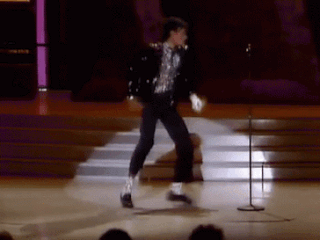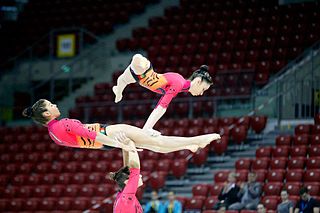
Gymnastics is a type of sport that includes physical exercises requiring balance, strength, flexibility, agility, coordination, artistry and endurance. The movements involved in gymnastics contribute to the development of the arms, legs, shoulders, back, chest, and abdominal muscle groups. Gymnastics evolved from exercises used by the ancient Greeks that included skills for mounting and dismounting a horse, and from circus performance skills.

In gymnastics, the floor is a specially prepared exercise surface, which is considered an apparatus. It is used by both male and female gymnasts. The gymnastics event performed on the floor is called floor exercise. The English abbreviation for the event in gymnastics scoring is FX.

The balance beam is a rectangular artistic gymnastics apparatus and an event performed using the apparatus. Both the apparatus and the event are sometimes simply referred to as "beam". The English abbreviation for the event in gymnastics scoring is BB. The beam is a small, thin beam which is typically raised from the floor on a leg or stand at both ends. The balance beam is only performed competitively by female gymnasts. Beams are usually covered with leather-like material and are only four inches wide.

Aerobics is a form of physical exercise that combines rhythmic aerobic exercise with stretching and strength training routines with the goal of improving all elements of fitness. It is usually performed to music and may be practiced in a group setting led by an instructor. With the goal of preventing illness and promoting physical fitness, practitioners perform various routines. Formal aerobics classes are divided into different levels of intensity and complexity and will have five components: warm-up, cardiovascular conditioning, muscular strength and conditioning, cool-down and stretching and flexibility. Aerobics classes may allow participants to select their level of participation according to their fitness level. Many gyms offer different types of aerobic classes. Each class is designed for a certain level of experience and taught by a certified instructor with a specialty area related to their particular class.

Samba is a lively dance of Afro-Brazilian origin in 2/4(2 by 4) time danced to samba music.

The moonwalk, or backslide, is a popping dance move in which the performer glides backwards but their body actions suggest forward motion. It became popular around the world when Michael Jackson performed the move during the performance of "Billie Jean" on Motown 25: Yesterday, Today, Forever, which was broadcast in 1983. He included the moonwalk in tours and live performances. Jackson has been credited as renaming the "backslide" to the moonwalk and it became his signature move.

Hip hop dance is a range of street dance styles primarily performed to hip hop music or that have evolved as part of hip hop culture. It is influenced by a wide range of styles that were created in the 1970s and made popular by dance crews in the United States. The television show Soul Train and the 1980s films Breakin', Beat Street, and Wild Style showcased these crews and dance styles in their early stages; therefore, giving hip-hop dance mainstream exposure.

The robot, also called mannequin or dancing machine, is a street dance style—often confused with popping—that suggests the stilted movements of a dancing robot or mannequin. Roboting gained fame in the 1970s after Michael Jackson used the dance when he performed "Dancing Machine" with his brothers.

Breaking, also called b-boying, b-girling or breakdancing, is a style of street dance developed by African American and Puerto Rican communities in The Bronx, New York City, United States.

Stepping or step-dancing is a form of percussive dance in African-American culture. The performer's entire body is used as an instrument to produce complex rhythms and sounds through a mixture of footsteps, spoken word, and hand claps. Though stepping may be performed by an individual, it is generally performed by groups of three or more, often in arrangements that resemble military formations.

A spin is a b-boying move that involves rotation of the breaker's body about some axis in contact with the ground. It is possible to perform a spin on virtually any part of the body, but bare skin often causes painful and spin-killing friction with the floor. To solve this problem, many breakers employ pieces of cloth or wear long clothing, pads, or caps. When the dancer uses his hands to aid in speeding up the spin, it is called tapping. A dancer may tap for a few rotations and then glide for subsequent rotations. Spins form an integral part of many breakers' routines, while others eschew them in favor of more complex-looking repeated movements, back and forth, after each rotation in a given direction.
In breakdancing, toprock is foot movement performed while standing, serving as the opening display of style, and as a warm-up for transitions into the more acrobatic maneuvers of downrock. It allows the dancer to demonstrate coordination, flexibility, rhythm and style. Breakers may devote considerable time to developing their toprock, and the style they display is a point of pride.

Acrobatic gymnastics is a competitive discipline of gymnastics where partnerships of gymnasts work together and perform figures consisting of acrobatic moves, dance and tumbling, set to music. There are three types of routines; a 'balance' routine where the focus is on strength, poise and flexibility; a 'dynamic' routine which includes throws, somersaults and catches, and a 'combined' routine which includes elements from both balance and dynamic.
America's Best Dance Crew, often abbreviated as ABDC, is an American competitive dance reality television series that features both national and international dance crews. The show was produced by singer, record producer, and former American Idol judge Randy Jackson. The series premiered on February 7, 2008, on MTV. It was originally developed for NBC as World Moves.
This is a general glossary of the terms used in the sport of gymnastics.
Super CR3W is a male assemblage of hip-hop dancers originating from Las Vegas, Nevada. The group won the second season Americas Best Dance Crew in the finals. Contrary to popular belief, Super CR3W was formed long before their appearance on Americas's Best Dance Crew, specifically in 2000. They wanted to bring the dance style, "Breakdancing/B-Boying" to the world.
So You Think You Can Dance (SYTYCD) is an American reality television dance competition show that currently airs on Fox in the United States and is the flagship series of the international So You Think You Can Dance television franchise. It was created by American Idol producers Simon Fuller and Nigel Lythgoe and is produced by 19 Entertainment and Dick Clark Productions The series premiered on July 20, 2005, with over ten million viewers and ended the summer season as the top-rated show on television. The first season was hosted by American news personality Lauren Sánchez. Since the second season, it has been hosted by English former children's television personality and game show emcee Cat Deeley.

The World Hip Hop Dance Championship is an international hip-hop dance competition created in 2002 by Hip Hop International co-founders Howard and Karen Schwartz, who also created the competitive dance reality television series America's Best Dance Crew. The competition is considered the largest dance competition in the world with more than 50 countries competing each year. The competition has been held since its inception in 2002, except in 2020 due to the COVID-19 pandemic.

Showtime is a type of performance Litefeet/pole dancing done as a busking routine using hand holds installed inside New York City Subway cars. Showtime includes acrobatic flips, hat and shoe tricks, and pole tricks. Estimates have placed the number of Showtime dancers in the low hundreds.
TeamGym is a form of competition created by the European Union of Gymnastics. The first official competition was held in Finland in 1996. Originally named EuroTeam, TeamGym received its current name in 2002. From 1996 to 2008, the European Championships was an event for clubs; since 2010 the competition is contested with national teams representing different countries. TeamGym events consist of three sections: women, men and mixed teams. Gymnasts perform skills in three different disciplines: floor, tumbling and trampette. In common for the performance is effective teamwork, good technique in the elements and spectacular acrobatic skills.














